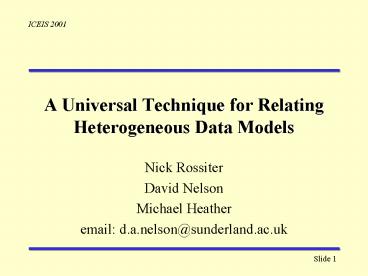A Universal Technique for Relating Heterogeneous Data Models - PowerPoint PPT Presentation
1 / 13
Title:
A Universal Technique for Relating Heterogeneous Data Models
Description:
Looking at multi-level architecture for information systems. Need to handle higher ... Format (IRD) StudentR StudentO Postgrad. Data DataUniDDR DataUniDDO Name ... – PowerPoint PPT presentation
Number of Views:43
Avg rating:3.0/5.0
Title: A Universal Technique for Relating Heterogeneous Data Models
1
A Universal Technique for Relating Heterogeneous
Data Models
- Nick Rossiter
- David Nelson
- Michael Heather
- email d.a.nelson_at_sunderland.ac.uk
2
Introduction
- Looking at multi-level architecture for
information systems - Need to handle higher levels than intension
- Take object work two levels higher to achieve
interoperability between heterogeneous systems - Formalisation using category theory and adjoints
- Example using relational and object oriented
databases
3
Outline IRDS
- Introduces concept of meta-meta data
- based on ISO/IEC Standards
- 10027 1990 Information Resource Dictionary
System (IRDS) - Four-level approach
- concepts
- constructions
- format
- data values
4
Extract IRDS Standard Framework
5
Relating Extension to Intension
- level example
- Application data Supplier(1,Smith)
- extension -direct
- addressing
- Schema data Supplier (supp_no, name)
- intension - addressing
- by name
- level pair
6
Relating Intension to Constructs
- Schema data Supplier (supp_no, name)
- intension - addressing
- by name
- Meta data Table(supplier)
- data dictionary - addressing
- by concepts, constructs.
7
Relating Constructs to Abstractions
- Meta data Table(Supplier)
- data dictionary - addressing
- by concepts, constructs.
- Meta meta data Aggregation(Table)
- real-world abstractions
- - addressing by abstractions
8
Interpretation of IRDS in Schematic form
- concepts mission
- MetaMeta Policy
- constructs management
- Meta
Organize - intension enterprise
- Name
Data - extension information
Information Resource Dictionary Definition
Schema (IRDDS)
Information Resource Dictionary Definition (IRDD)
Information Resource Dictionary (IRD)
Information Resource Data (APP)
9
Formalization of IRDS Approach
- Quality enhanced by formalization
- Can know more confidently the limits and
behaviour of a system - Which formalism is best-suited?
10
Category Theory?
- Need relations to represent level-pairs
- Multi-level construction (higher-order)
- Category theory seems appropriate
- - categories for basic structures
- - functors relate categories
- - natural transformations relate functors
11
Adjointness
12
Relational/OO Example
- Concept (IRDDS) Inheritance
- Policy MetaMeta
- Constructs (IRDD) InherTable ltSubtype,
Supertypegt - Organize OrgUniDDR
OrgUniDDO Meta - Format (IRD) StudentR StudentO Postgrad
- Data DataUniDDR
DataUniDDO Name - Values StudentR1234, James, 1234, James,
1234, The Language X - (APP) 15 Montfort Ave, The Language X 15
Montfort Ave
13
Conclusions
- Interoperability is considered in the context of
ISO Information Resource Dictionary System - Provides a complete definition of an information
system from real world abstractions through
constructs employed to real data - Levels in IRDS can be mapped using category
theory concept of adjoints - Future work to develop model and test
constructions for a variety of data models































